 The Lookout
The LookoutIs Fed’s job forecast too rosy?

The Federal Reserve's predictions on unemployment over the next few years aren't all that encouraging. But could they actually be too optimistic.
The Fed said yesterday it expects joblessness, currently at 9.1 percent, to come down by almost 2 full percentage points by the end of 2013. But it also said it expects GDP growth to average around 3.4 percent during that period.
Economists have a rule that governs the relationship between GDP growth and unemployment. It's called Okun's Law. And as Justin Wolfers, a prominent economist at the University of Pennsylvania's Wharton School points out, Okun's Law indicates that growth of 3.4 percent over that timeframe will cause unemployment to drop by only about half a percentage point--at best a quarter of what the Fed predicts.
"The Fed's output forecasts combined with Okun's law suggests that there's real reason to be concerned that by early 2014, the unemployment rate may still be as high as 8.5 percent," Wolfers writes.
Another point he doesn't add: Even a half a percentage point reduction over two and a half years, though paltry, could be an over-optimistic assessment. As we've written, there's evidence that the relationship between growth and jobs is changing, as more jobs are shipped overseas and labor loses bargaining power. That means Okun's Law may need tweaking--to reflect that growth may now produce fewer jobs.
(Unemployed day worker Efren Martinez looks back before coming into his rental apartment in the Westlake district of Los Angeles, Sept. 7, 2010. AP Photo/Damian Dovarganes)
